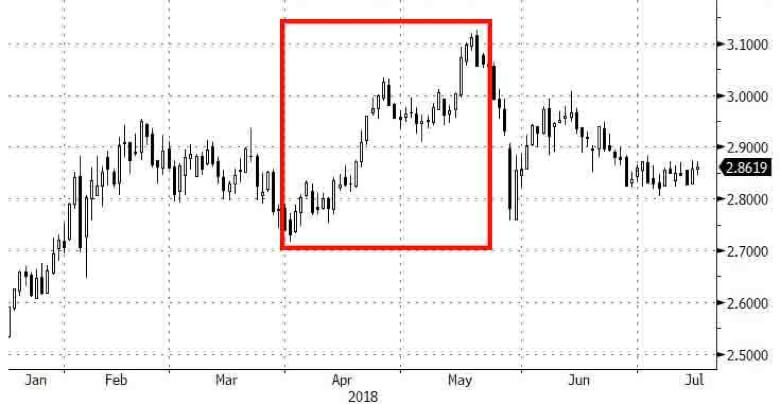Where Russia has transferred billions of US government debt
Russia has reduced its participation in the US national debt to its lowest level since 2007. Such a maneuver was most likely caused by the April sanctions. However, there are not so many alternatives to US government bonds. Forbes.

depositphotos.com
Russia's participation in the US national debt declined to $ 15 billion in May, although at the beginning of the year this figure exceeded $ 100 billion. Russia did not have such a low volume of US government bonds since 2007. This news has generated a lot of speculation, which can easily be classified as conspiracy theories and not seriously considered, but a couple of questions still need to be answered. In particular, where the released funds will be invested.
Impact of sanctions
First of all, you need to understand that the data on the actual sale of US debts by the Bank of Russia was not reported. American statistics are published with a time lag of one and a half months at the end of each calendar month. It contains holders of treasury securities by country without detail.
From March to May, there is a sharp decline in the share of holders from Russia. The Central Bank itself reveals the structure of its reserves only with a lag of six months, so you can only speculate on how many of these almost $ 80 billion were actually sold by the Russian regulator.
Most of the experts who commented on these statistics in “hot pursuit”, noted potential investors' fears before the meeting of the leaders of the United States and Russia in terms of increasing sanctions.
But if you raise the history of agreeing on the date of the summit itself, which took place on 16 in July in Helsinki, you can see that sales took place long before the fact of the meeting was recorded - during April and May. Meanwhile, some certainty about the place and time of negotiations between the presidents appeared only in late May - early June.
From our point of view, the main factor that has prompted so far the “anonymous” sellers of American debt to hastily close their positions have become, not potential July, but real April sanctions. On April 6, the toughest measures against Russia in recent years were announced, including many significant Russian businessmen on the SDN list.
This conclusion confirms the behavior of prices on US government bonds in the period under review. On the chart of US 10-year yields, you can clearly trace the segment of almost non-stop growth in yields from the end of the first decade of April to the middle of the second decade of May. This indicates the predominance of paper sellers over buyers.

The presence of a large seller on the market, and in such a difficult period for the American debt, the Fed rate hike could become a serious factor that shifted the balance towards supply. This version is also supported by the fact that at the beginning of May - traditionally non-working days in Russia - the market got a breather, and then sales and yield growth continued.
Of course, Russia has never been the largest player in the US government debt market. Its volume is more than $ 15 trillion, and the Russian part in recent years has not even reached 1% of this amount. Nevertheless, the "fire sale" could lead to a local panic in the market, which can be observed on the graph below. After the seller “ran out of ammunition,” the returns returned to the 2,75-2,9% corridor, where they have been since February.
Where did the money go
There are not so many alternative accommodation options for $ 80 billion. Immediately doomed ideas like bridge loans to the governments of the friendly countries of Russia are swept aside. The mandate of the Central Bank does not allow such escapades.
Gold is a good product, but it is extremely difficult to buy physical gold for $ 80 billion. If we start from the average daily trading volume of all kinds of derivatives for this metal in $ 120-130 billion and the fact that the paper market is approximately 97% of all circulating gold, we can estimate the daily turnover of the metal itself in $ 3-4 billion. The Central Bank will face the task of collecting a month and a half from the market.
To do this without affecting the price is extremely difficult, and it is unlikely that the Russian regulator is seriously considering such actions. Nevertheless, the Central Bank still increases the amount of physical gold in reserves - over the past year and a half, the cost of precious metals in the portfolio of gold and foreign exchange reserves increased from $ 60 billion to $ 80 billion.
Other options are worse. Debt obligations in the yen, the Swiss franc and the euro bring either zero income, or generally negative. However, they do not remove the risk of falling under the sanctions. For example, Japan stopped buying oil from Iran, not even waiting for the first official punishments of violators of Tehran’s boycott.
The Yuan is still not a fully recognized international means of payment, and the placement of any significant part of the reserves in Chinese currency is not on the agenda at all.
If we remain in dollars, then the options are narrowed to deposits in the International Monetary Fund and foreign commercial banks with a rating not lower than “A” on the S&P and Fitch scale or “A2” according to Moody's.
Also available for placement are bonds of other issuers with a rating not lower than "АА-" on the S&P and Fitch scale or "Aa3" according to Moody's, or just cash currency before the wind changes to a tailwind. But, if the guess about the withdrawal of funds from the sanctions is correct, bank deposits also “fly out”, leaving the Central Bank with money in hand until relations with the United States improve.
If the conciliatory statements made at the conference following the summit in Helsinki lead to a detente or a reset of relations between the United States and Russia, the return of the American government debt to our gold and foreign exchange reserves looks real. Especially since the rates on short-term securities up to one year are at multi-year highs.
Read also on ForumDaily:
How the US banking system works and how reliable it is
As a foreigner to get a loan for housing in New York: instructions and pitfalls
Subscribe to ForumDaily on Google NewsDo you want more important and interesting news about life in the USA and immigration to America? — support us donate! Also subscribe to our page Facebook. Select the “Priority in display” option and read us first. Also, don't forget to subscribe to our РєР ° РЅР ° Р »РІ Telegram and Instagram- there is a lot of interesting things there. And join thousands of readers ForumDaily New York — there you will find a lot of interesting and positive information about life in the metropolis.











